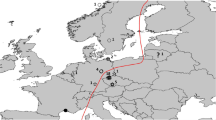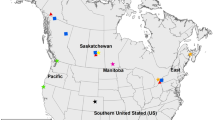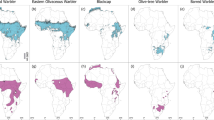Abstract
To investigate migratory connectivity in the Reed Warbler Acrocephalus scirpaceus, we analysed (1) all available sub-Saharan ringing recoveries and (2) stable isotopes in feathers grown in Africa sampled at 17 European breeding sites across a migratory divide. A cluster analysis of ringing recoveries showed remarkable connectivity between breeding and non-breeding grounds. Two main clusters represented populations taking the two main migratory routes [southwesterly (SW) and southeasterly (SE)]. Stable isotope analysis confirmed the separation of wintering areas of SW- and SE-migrating populations. Higher δ15N values in feathers of SE-migrating birds indicated that they occupied more xeric biome types. Values of δ13C that did not differ significantly among populations were higher than those from feathers of known European origin and indicated a C4 biome. Three populations with an unknown migratory direction were assigned to the SE-migrating populations on the basis of δ15N values.





Similar content being viewed by others
References
Alisauskas RT, Klaas EE, Hobson KA, Ankney CD (1998) Stable-carbon isotopes support use of adventitious color to discern winter origins of lesser snow geese. J Field Ornithol 69:262–268
Ambrose SH (1991) Effects of diet, climate and physiology on nitrogen isotope abundance in terrestrial food webs. J Arch Sci 18:293–317
Bairlein F (2003) The study of bird migrations—some future perspectives. Bird Study 50:243–253
Bensch S, Bengtsson G, Åkesson S (2006) Patterns of stable isotope signatures in willow warbler feathers collected in Africa. J Avian Biol 37:323–330
Boulet M, Gibbs HL, Hobson KA (2006) Integrated analysis of genetic, stable isotope, and banding data reveal migratory connectivity and flyways in the northern yellow warbler (Dendroica petechia; aestiva group). Ornithol Monogr 61:29–78
Chamberlain CP, Bensch S, Feng X, Åkesson S, Andersson T (2000) Stable isotopes examined across a migratory divide in Scandinavian willow warblers (Phylloscopus trochilus trochilus and Phylloscopus trochilus acredula) reflect their African winter quarters. Proc R Soc B 267:43–48
Clegg SM, Kelly JF, Kimura M, Smith TB (2003) Combining genetic markers and stable isotopes to reveal population connectivity and migration patterns in a Neotropical migrant, Wilson’s warbler (Wilsonia pusilla). Mol Ecol 12:819–830
Cramp JS (1992) The birds of the Western Palearctic. In: Warblers, vol 6. Oxford University Press, Oxford
Donovan T, Buzas J, Jones P, Gibbs HL (2006) Tracking dispersal in birds: assessing the potential of elemental markers. Auk 123:500–511
Dowsett-Lemaire F, Dowsett RJ (1987) European reed and marsh warblers in Africa: migration patterns, moult and habitat. Ostrich 58:65–85
Evans KL, Waldron S, Bradbury RB (2003) Segregation in the African wintering ranges of English and Swiss swallow Hirundo rustica populations: a stable isotope study. Bird Study 50:294–299
Farquhar GD, Richards RA (1984) Isotopic composition of plant carbon correlates with water use efficiency of wheat genotypes. Aust J Plant Physiol 11:539–552
Féret M, Gauthier G, Béchet A, Giroux J-F, Hobson KA (2003) Impact of a spring hunt on nutrient storage by greater snow geese in southern Québec. J Wildl Manage 67:796–807
Gunnarsson TG, Gill JA, Newton J, Sutherland WJ (2005) Seasonal matching of habitat quality and fitness in a migratory bird. Proc R Soc B 272:2319–2323
Heaton THE (1987) The 15N/14N ratios of plants in South Africa and Namibia: relationship to climate and coastal/saline environments. Oecologia 74:236–246
Heaton THE, Vogel JC, von la Chevallerie G, Gollet G (1986) Climatic influence on the isotopic composition of bone nitrogen. Nature 322:822–823
Helbig AJ, Berthold P, Wiltschko W (1989) Migratory orientation of blackcaps (Sylvia atricapilla): population-specific shifts of direction during the autumn. Ethology 82:307–315
Hobson KA (2005) Using stable isotopes to trace long-distance dispersal in birds and other taxa. Divers Distrib 11:157–164
Hobson KA, Bowen GJ, Wassenaar LI, Ferrand Y, Lormee H (2004) Using stable hydrogen and oxygen isotope measurements of feathers to infer geographical origins of migrating European birds. Oecologia 141:477–488
Imboden C, Imboden D (1972) Formel für Orthodrome und Loxodrome bei der Berechnung von Richtung und Distanz zwischen Beringungs- und Wiederfundort. Vogelwarte 26:336–346
Jenni L, Winkler R (1994) Moult and ageing of European passerines. Academic Press, London
Kelly JF (2000) Stable isotopes of carbon and nitrogen in the study of avian and mammalian trophic ecology. Can J Zool 78:1–27
Kelly JF, Ruegg KC, Smith TB (2005) Combining isotopic and genetic markers to identify breeding origins of migrant birds. Ecol Appl 15:1487–1494
Leisler B (1981) Die ökologische Einnischung der mitteleuropäischen Rohrsänger (Acrocephalus, Sylviinae). I. Habitattrennung. Vogelwarte 31:45–74
Lott CA, Smith JP (2006) A geographic-information-system approach to estimating the origin of migratory raptors in North America using stable hydrogen isotope ratios in feathers. Auk 123:822–835
Lozano GA, Perreault S, Lemon RE (1996) Age, arrival date and reproductive success of male American redstarts Setophaga ruticilla. J Avian Biol 27:164–170
Marra PP, Hobson KA, Holmes RT (1998) Linking winter and summer events in a migratory bird by using stable-carbon isotopes. Science 282:1884–1886
Morel M-Y (1987) Acrocephalus scirpaceus et Acrocephalus baeticatus dans la région de Richard-Toll (Sénégal). Malimbus 9:47–55
Neto JM, Newton J, Gosler AG, Perrins CM (2006) Using stable isotope analysis to determine the winter moult extent in migratory birds: the complex moult of Savi’s warblers Locustella luscinioides. J Avian Biol 37:117–124
Newton I (2004) Population limitation in migrants. Ibis 146:197–226
Newton I (2006) Can conditions experienced during migration limit the population levels of birds? J Ornithol 147:146–166
Norris DR (2005) Carry-over effects and habitat quality in migratory populations. Oikos 109:178–186
Norris DR, Marra PP, Kyser TK, Sherry TW, Ratcliff LM (2004) Tropical winter habitat limits reproductive success on the temperate breeding grounds in a migratory bird. Proc R Soc B 271:59–64
O’Leary MH (1981) Carbon isotope fractionation in plants. Phytochemistry 20:553–567
Pain DJ, Green RE, Giessing B, Kozulin A, Poluda A, Ottosson U, Flade M, Hilton GM (2004) Using stable isotopes to investigate migratory connectivity of the globally threatened aquatic warbler Acrocephalus paludicola. Oecologia 138:168–174
Peach WJ, Baillie SR, Underhill L (1991) Survival of British sedge warblers (Acrocephalus schoenobaenus) in relation to west African rainfall. Ibis 133:300–305
Pearson DJ (1982) The migration and wintering of Palaearctic Acrocephalus warblers in Kenya and Uganda. Scopus 6:49–59
Redfern CPF, Alker P (2002) Eurasian Reed Warbler (Acrocephalus scirpaceus). In: Wernham CV, Toms MP, Marchant JH, Clark JA, Siriwardena GM, Baillie SR (eds) The migration atlas: movements of the birds of Britain and Ireland. T & AD Poyser, London, pp 548–551
Remisiewicz M (2002) The spatio-temporal pattern to robin Erithacus rubecula migration—evidence from ringing recoveries. Ardea 90(special issue):489–502
Saino N, Szép T, Romano M, Rubolini D, Spina F, Møller AP (2004) Ecological conditions during winter predict arrival date at the breeding quarters in a trans-Saharan migratory bird. Ecol Lett 7:21–25
Salomonsen F (1955) The evolutionary significance of bird migration. Det Kgl Danske Vidensk Selsk Biologiske Medd 22:1–62
Schaub M, Kania W, Koppen U (2005) Variation of primary production during winter induces synchrony in survival rates in migratory white storks Ciconia ciconia. J Anim Ecol 74:656–666
Schlenker R (1988) Zum Zug der Neusiedlersee (Österreich)-Population des Teichrohrsängers (Acrocephalus scirpaceus) nach Ringfunden. Vogelwarte 34:337–343
Sealy JC, Van der Merwe NJ, Lee-Thorp JA, Lanhamm JL (1987) Nitrogen isotopic ecology in southern Africa: implications for environmental and dietary tracing. Geochim Cosmochim Acta 51:2707–2717
Smith BN, Epstein S (1971) Two categories of 13C/12C ratios for higher plants. Plant Physiol 47:380–384
Smith RJ, Moore FR (2005) Arrival timing and seasonal reproductive performance in a long-distance migratory landbird. Behav Ecol Sociobiol 57:231–239
StatSoft Inc. (2001) STATISTICA (data analysis software system), version 6. http://www.statsoft.com
Still CJ, Berry JA, Collatz GJ, DeFries RS (2003) Global distribution of C3 and C4 vegetation: carbon cycle implications. Global Biogeochem Cycles 17:1006–1029
Studds CE, Marra PP (2005) Nonbreeding habitat occupancy and population processes: an upgrade experiment with a migratory bird. Ecology 86:2380–2385
Szép T (1995) Relationship between West African rainfall and the survival of central European bank swallows Riparia riparia. Ibis 137:162–168
Szép T, Møller AP (2006) Searching for potential wintering and migration areas of a Danish barn swallow population in South Africa by correlating NDVI with survival estimates. J Ornithol 147:245–253
Szép T, Møller AP, Vallner J, Kovács B, Norman D (2003) Use of trace elements in feathers of sand martin Riparia riparia for identifying moulting areas. J Avian Biol 34:307–320
Toschi A (1969) Introduzione alla ornitologia della Libia. Suppl Ric Zool Appl Caccia Bologna 6:1–381
Urban EK, Fry CH, Keith S (eds) (1997) The birds of Africa, vol 5. Academic Press, London
Van der Merwe NJ, Lee-Thorp JA, Thackeray JF, Hall-Martin A, Kruger FJ, Coetzee H, Bell RH, Lindeque M (1990) Source-area determination of elephant ivory by isotopic analysis. Nature 346:744–746
Webster MS, Marra PP (2005) The importance of understanding migratory connectivity and seasonal interactions. In: Greenberg R, Marra PP (eds) Birds of two worlds: the ecology and evolution of migration. Johns Hopkins University Press, Baltimore, pp 199–209
Webster MS, Marra PP, Haig SM, Bensch S, Holmes RT (2002) Links between worlds: unraveling migratory connectivity. Trends Ecol Evol 17:76–83
Yohannes E, Hobson KA, Pearson DJ, Wassenaar LI (2005) Stable isotope analyses of feathers help identify autumn stopover sites of three long-distance migrants in northeastern Africa. J Avian Biol 36:235–241
Yohannes E, Hobson KA, Pearson DJ (2007) Feather stable-isotope profiles reveal stopover habitat selection and site fidelity in nine migratory species moving through sub-Saharan Africa. J Avian Biol 38:347–355
Zink G (1973) Der Zug europäischer Singvögel. Ein Atlas der Wiederfunde beringter Vögel. Lieferung 1. Vogelzug-Verlag, Möggingen
Zink G (1977) Richtungsänderungen auf dem Zuge bei europäischen Singvögeln. Vogelwarte 27:44–54
Acknowledgments
Thanks are due to an untold army of ringers in reed beds who have sampled a respectable number of recoveries over several decades. We are grateful to the EURING schemes which made their recoveries available and to Chris du Feu who sent us the data. Julia Bojarinova, Jaroslav Cepák, Alan Crabtree and Ray Galea kindly provided additional recoveries. Javier R. Álvarez (Grupo Phylloscopus), Bruno Bargain, Stefan Bräger, Froukje and Kees Breek, Charles Coleiro, Vladimir Fedorov, Ray Galea, Jiří Reif, Sergio Scebba (Gruppo Inanellamento Limicoli), Rob J. Thomas and Alfréd Trnka selflessly sampled feathers at their sites, Luka Jurinović helped with netting in Croatia. Eliza Yohannes and Vladislav Kosarev provided unpublished feather stable isotope measurements of birds from Rybachy. Mano Benjamin and Blanca Mora Alvarez assisted with the preparation of samples for stable isotope analyses. Jan Zárybnický and several other people made various contributions. Suggestions of Milica Požgayová and anonymous referees helped to improve earlier versions of the manuscript. Sampling adhered to the legal and ethical requirements in all the countries involved. PP was supported by GA AV CR (grant no. KJB600930508), ESF BIRD Programme and Croatian-Czech inter-academy exchange, and KAH was supported by an operating grant from Environment Canada.
Author information
Authors and Affiliations
Corresponding author
Additional information
Communicated by F. Bairlein.
Rights and permissions
About this article
Cite this article
Procházka, P., Hobson, K.A., Karcza, Z. et al. Birds of a feather winter together: migratory connectivity in the Reed Warbler Acrocephalus scirpaceus . J Ornithol 149, 141–150 (2008). https://doi.org/10.1007/s10336-007-0250-1
Received:
Revised:
Accepted:
Published:
Issue Date:
DOI: https://doi.org/10.1007/s10336-007-0250-1




